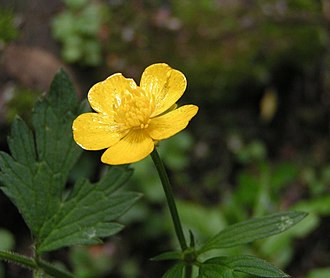Translations:Adventist Youth Honors Answer Book/Outdoor Industries/Agriculture/16/en
From Pathfinder Wiki
Ranunculus repens
| Ranunculus repens (Creeping Buttercup) | |
|---|---|
|
Where found: Native to Europe, Asia and northwestern Africa. Introduced to North America.
Description: Creeping Buttercup is a herbaceous, stoloniferous perennial plant growing to 50 cm tall. It has both prostrate running stems, which produce roots and new plants at the nodes, and more or less erect flowering stems. The basal leaves are divided into three broad leaflets 1.5–8 cm long, shallowly to deeply lobed, borne on a 4–20 cm long petiole; leaves higher on the stems are smaller, with narrower leaflets. Both the stems and the leaves are finely hairy. The flowers are bright golden yellow, 2–3 cm diameter, usually with five petals. The fruit is a cluster of achenes 2.5–4 mm long. Creeping buttercup has three-lobed dark green, white-spotted leaves that grow out of the node. It grows in fields and pastures and prefers wet soil.
Control: From the USDA
|
 |
